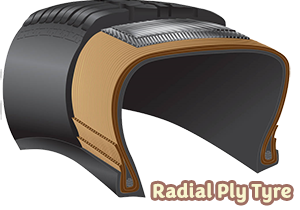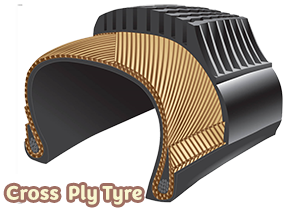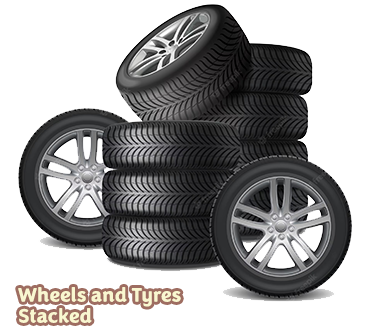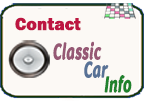
Maintaining the tires on a classic car should be one of the least challenging aspects of the entire project. The obvious reaon is that not even the most avid restorer would ever consider restoring tires on a vehicle that may have been off the road for decades.
 Instead the restorer will have made their way to a specialist tire centre, and make their decision on which tire they should go for -dependant on their visions for the vehicle.
Instead the restorer will have made their way to a specialist tire centre, and make their decision on which tire they should go for -dependant on their visions for the vehicle.
Despite that there remain e some restoration purists who would say that their classic car should be fitted with the same tire as the original. Something that is difficult to find but not impossible.
Most classic car owners who plan to use their vehicle on a regular basis have a simple choice between vintage bias ply tires or modern radial tires. Once the decision has been made and the tires fitted, its time to hit the road- hopefully with a tire maintenance back up plan behind them.
The plan should based as follows:
![]() Check the air pressure in all four tires on a regular basis, While it may appear to be a mundane task, inflating tires is much more important to the car than you may realise, resulting in a safer and more economical driving experience. Proper tire inflation can significantly improve the vehicle's fuel economy.
Check the air pressure in all four tires on a regular basis, While it may appear to be a mundane task, inflating tires is much more important to the car than you may realise, resulting in a safer and more economical driving experience. Proper tire inflation can significantly improve the vehicle's fuel economy.

 The vehicle's handling will also be greatly improved since the larger the inflated footprint of a tire, the more responsive and comfortable the ride balance will be. There may still be a sticker on the driver's side doorjamb to determine the proper inflation level for your tires. If so it will it show the vehicle weight limit as well as tire information, including the recommended tire pressure. Details of recommended tire pressure can also be found in the maintenance manual or even in the garage forecourt.
The vehicle's handling will also be greatly improved since the larger the inflated footprint of a tire, the more responsive and comfortable the ride balance will be. There may still be a sticker on the driver's side doorjamb to determine the proper inflation level for your tires. If so it will it show the vehicle weight limit as well as tire information, including the recommended tire pressure. Details of recommended tire pressure can also be found in the maintenance manual or even in the garage forecourt.
![]() Never rely on the tire's sidewall markings, which specify the optimum tire pressure — not the suggested pressure for your vehicle.
Never rely on the tire's sidewall markings, which specify the optimum tire pressure — not the suggested pressure for your vehicle.
![]() Check the tread depth on all four tires to make sure they have enough tread to provide good traction. The minimum recommended tread depth is usually around 2/32 of an inch. It is important to not only check each tire, but also the areas around each tire. Start by paying close attention to the areas that seem to be the most worn. Even if your tread is deeper than 2/32" on average, the tire should still be replaced if any areas come up short in the test. Consistent tread wear is common, but uneven tread wear could suggest improper inflation, wheel misalignment, or perhaps a variety of other issues. If you recognize uneven tread wear, you should have your vehicle inspected by a technician.
Check the tread depth on all four tires to make sure they have enough tread to provide good traction. The minimum recommended tread depth is usually around 2/32 of an inch. It is important to not only check each tire, but also the areas around each tire. Start by paying close attention to the areas that seem to be the most worn. Even if your tread is deeper than 2/32" on average, the tire should still be replaced if any areas come up short in the test. Consistent tread wear is common, but uneven tread wear could suggest improper inflation, wheel misalignment, or perhaps a variety of other issues. If you recognize uneven tread wear, you should have your vehicle inspected by a technician.
![]() Rotate the tires at the recommended intervals, typically every 5,000 to 7,500 miles or according to the car's manual, to ensure even wear and extend the life of the tires.
Rotate the tires at the recommended intervals, typically every 5,000 to 7,500 miles or according to the car's manual, to ensure even wear and extend the life of the tires.
![]() Inspect the tires for any visible signs of damage or wear, such as cuts, bruises, bulges, or irregular wear patterns. These can indicate a problem with the tires and should be addressed as soon as possible.
Inspect the tires for any visible signs of damage or wear, such as cuts, bruises, bulges, or irregular wear patterns. These can indicate a problem with the tires and should be addressed as soon as possible.

![]() Balance the tires every time they are rotated ensuring even wear and prevent vibrations at highway speed
Balance the tires every time they are rotated ensuring even wear and prevent vibrations at highway speed
![]() : Have the alignment checked at least once a year. Improper alignment can cause the vehicle to pull to one side and meaning that tire wear will be uneven.
: Have the alignment checked at least once a year. Improper alignment can cause the vehicle to pull to one side and meaning that tire wear will be uneven.

![]() If the classic car is going to be in storage for a long period, it is good advice to remove the tires and store them in a cool, dry place to prevent dry rot. Tires should ideally be stored indoors in a clean, cool, and dark location away from direct sunlight, excess heat and h as hot pipes or electric generators.
If the classic car is going to be in storage for a long period, it is good advice to remove the tires and store them in a cool, dry place to prevent dry rot. Tires should ideally be stored indoors in a clean, cool, and dark location away from direct sunlight, excess heat and h as hot pipes or electric generators.
If the tires are being stored outside (only recommended for a short period of time), they should be raised off the ground, and stored under a waterproof protective cover with gaps to prevent moisture accumulation.
Regular inspection and maintenance will extend the life of your classic car's tires and can avoid costly repairs in the future.
ub4





